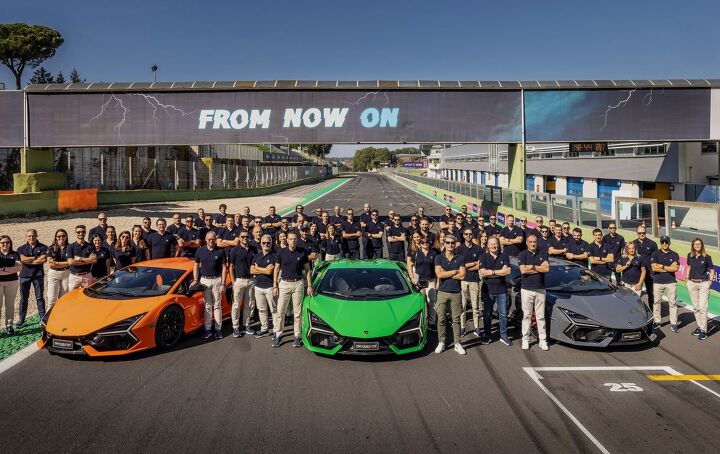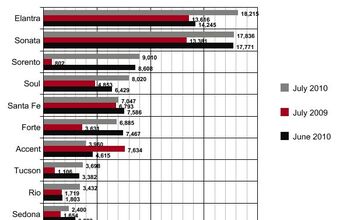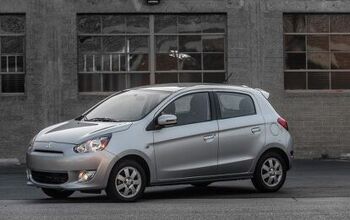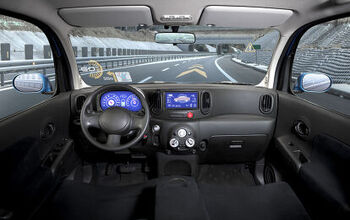Lamborghini Breaks Historic Sales Record

Lamborghini has broken its own sales record by delivering over 10,000 automobiles in 2023. While that’s still less than mainstream manufacturers are pushing out the door in a given week, it represents a major shift in how the brand does business and will likely open it up to additional regulatory scrutiny.
Sales were primarily driven by the Urus, with 6,087 vehicles delivered, and the Huracán, boasting 3,962 units. Analysts have suggested that something like this may not have been possible a decade ago. But with global wealth being transferred upward in recent years, Lamborghini was afforded an opportunity to draw in additional customers with its entry level products. Though, despite these being Lamborghini’s most affordable models, both the Huracán and Urus retail well above $200,000.
From Lamborghini:
The distribution of vehicles delivered was balanced in the three macro-regions, with EMEA showing a 14 [percent] increase over 2022 with a total of 3,987 cars, immediately followed by Americas with a 9 [percent] increase (Total: 3,465) and APAC up 4 [percent] (Total: 2,660). In detail, the United States continued as the top market with 3,000 cars delivered, followed by Germany (961), Chinese Mainland, Hong Kong and Macau (845), the United Kingdom (801), Japan (660), the Middle East (496), South Korea (434), Italy (409), Canada (357), Australia (263), France & Monaco (255), Switzerland (211), Taiwan (131) and India (103).
In terms of model split, the continuing success of the Urus Super SUV was confirmed (6,087 vehicles delivered), followed by another notable record for the Huracán, of which 3,962 cars were delivered. In addition, 63 cars equipped with the iconic V12 were delivered, including the last 12 Aventadors and 51 Few-Offs.
“It’s a true source of pride for the whole company to have surpassed the 10,000-car delivery mark. Playing a role in achieving this milestone for Lamborghini is an honor for me and for all the people who work tirelessly to achieve this goal,” stated Stephan Winkelmann, Chairman and CEO of Automobili Lamborghini. “This is a success made possible by the commitment of everyone, a major accomplishment based on true teamwork. But as always, we’re not stopping at single milestones, and we’re ready to take on more exciting new challenges in 2024.”
While the sales are good news for the brand, breaking the 10,000-unit barrier could come with some complications. The European Union had previously considered allowing specialty, low-volume manufacturers leeway when it comes to adhering to ever-tightening emissions rules. But it has started to move away from the scheme and is still planning to force all manufacturers to stop building everything but all-electric vehicles by 2035. While companies building fewer than 10,000 vehicles annually weren’t subject to the same emissions standards as the big boys, they’re still supposed to prepare for electrification if they want to continue doing business in Europe.
A subset of boutique manufacturers have attempted to convince the EU to rethink the plan by offering exemptions to low-volume brands on the grounds that their products aren’t transportation products but mobile works of rolling art. The premise is that they’re different from mainstream automobiles and should be treated as such.
“We create art pieces that exist for 100 years or more, so they’re not mass-production cars you throw away after 15 years,” Donkervoort Automobielen Managing Director Denis Donkervoort said early in 2023. “We know this because more than 99 [percent] of the cars we’ve ever built are still drivable, and we know this because we still service them.”
Donkervoort and a handful of other low-volume manufacturers are hoping to get around European regulations that would force them to halve CO2 emissions by 2030 and go fully electric by 2035. But they’re targeting an indefinite exemption for automakers building fewer than 1,000 vehicles per year, which wouldn’t pertain to Lamborghini even if it stopped selling the Urus tomorrow.
The theory here could be applied to companies like Lamborghini, however. Boutique brands have alleged that they produce vehicles in such small quantities that the overall carbon footprint is minuscule. Though the kind of people that buy those products are likely to have a much larger impact on the environment than your neighbor who drives an Honda CR-V and won’t need to heat a 10,000 square-foot mansion or fuel the private jet they also don’t own.
Regardless, Lamborghini now sells enough cars to put itself into a different category unless industry regulators are swayed by corporate lobbying efforts. But the Italian brand has fielded several all-electric concepts in recent years and has claimed 2024 will represent its first big push into transitioning its fleet to EVs, now that the time it allotted itself as a “celebration of the internal combustion engine” has concluded.
[Image: Lamborghini]
Become a TTAC insider. Get the latest news, features, TTAC takes, and everything else that gets to the truth about cars first by subscribing to our newsletter.

A staunch consumer advocate tracking industry trends and regulation. Before joining TTAC, Matt spent a decade working for marketing and research firms based in NYC. Clients included several of the world’s largest automakers, global tire brands, and aftermarket part suppliers. Dissatisfied with the corporate world and resentful of having to wear suits everyday, he pivoted to writing about cars. Since then, that man has become an ardent supporter of the right-to-repair movement, been interviewed on the auto industry by national radio broadcasts, driven more rental cars than anyone ever should, participated in amateur rallying events, and received the requisite minimum training as sanctioned by the SCCA. Handy with a wrench, Matt grew up surrounded by Detroit auto workers and managed to get a pizza delivery job before he was legally eligible. He later found himself driving box trucks through Manhattan, guaranteeing future sympathy for actual truckers. He continues to conduct research pertaining to the automotive sector as an independent contractor and has since moved back to his native Michigan, closer to where the cars are born. A contrarian, Matt claims to prefer understeer — stating that front and all-wheel drive vehicles cater best to his driving style.
More by Matt Posky
Latest Car Reviews
Read moreLatest Product Reviews
Read moreRecent Comments
- Steve S. Steve was a car guy. In his younger years he owned a couple of European cars that drained his bank account but looked great and were fun to drive while doing it. This was not a problem when he was working at a good paying job at an aerospace company that supplied the likes of Boeing and Lockheed-Martin, but after he was laid off he had to work a number of crummy temp jobs in order to keep paying the rent, and after his high-mileage BMW was totaled in an accident, he took the insurance payout and decided to get something a little less high maintenance. But what to get? A Volkswagen? Maybe a Volvo? No, he knew that the parts for those were just as expensive and they had the same reputation for spending a lot of time in the shop as any other European make. Steve was sick and tired of driving down that road."Just give me four wheels and a seat," said Steve to himself. "I'll buy something cooler later when my work situation improves".His insurance company was about to stop paying for the rental car he was driving, so he had to make a decision in a hurry. He was not really a fan of domestics but he knew that they were generally reliable and were cheap to fix when they did break, so he decided to go to the nearest dealership and throw a dart at something.On the lot was a two year old Pontiac Sunfire. It had 38,000 miles on it and was clean inside and out. It looked reasonably sporty, and Steve knew that GM had been producing the J-car for so long that they pretty much worked the bugs out of it. After taking a test drive and deciding that the Ecotec engine made adequate power he made a deal. The insurance check paid for about half of it, and he financed the rest at a decent rate which he paid off within a year.Steve's luck took a turn for the better when he was offered a job working for the federal government. It had been months since he went on the government jobs website and threw darts at job listings, so he was surprised at the offer. It was far from his dream job, and it didn't pay a lot, but it was stable and had good benefits. It was the "four wheels and a seat" of jobs. "I can do this temporarily while I find a better job", he told himself.But the year 2007 saw the worst economic crash since the Great Depression. Millions of people were losing their jobs, the housing market was in a free fall, people were declaring bankruptcy left and right, and the temporary job began to look more and more permanent. Steve didn't like his job, and he hated his supervisors, but he considered himself lucky that he was working when so many people were not. And the federal government didn't lay people off.So he settled in for the long haul. That meant keeping the Sunfire. He didn't enjoy it, but he didn't hate it either, and it did everything he asked of it without complaint.Eventually he found a way to tolerate his job too, and he built seniority while paying off his debts. There was a certain feeling of comfort and satisfaction of being debt-free, and he even began to build some savings, which was increasingly important for someone now in their forties.Another bit of luck came a few years later when Steve's landlord decided to sell the house Steve was renting, at the bottom of the housing market, and offered it to Steve for what he had in it. Steve's house was small and cramped, and he didn't really like it, but thanks to his savings and good credit he became a homeowner in an up and coming neighborhood.Fourteen years later Steve was still working that temporary job, still living in that cramped little house that he now hated, and still drove the Sunfire because it wouldn't die. For years now he dreamed of making a change, but then the pandemic happened and threw the economy and life in general into chaos. Steve weathered the pandemic, kept his job when millions of people were losing theirs, and sheltered in place in that crummy little house, with Netflix, HBO, and a dozen other streaming services keeping him company, and drove to and from work in the Sunfire because it was four wheels and a seat and that's all he needed for now.Steve's life was secure, but a kind of dullness had set in. He existed, but the fire went out; even when the pandemic ended and life returned to normal Steve's life went on as it had for years; an endless Groundhog Day of work, home, work, home. He never got his real-estate license or finished college and got his bachelor's, never got a better job, never used his passport to do some traveling in Europe. He lost interest in cars. "To think how much money I wasted on hot cars when I was younger", he said to himself. He never married and lost interest in dating. "No woman would want me anyway. I've gotten so dull and uninteresting that I even bore myself".Eventually the Sunfire began to give trouble. With 200,000 miles on the clock it was leaking oil, developing electrical gremlins, and wallow around on blown-out shocks. Steve wasn't hurting for money and thought about treating himself to a new car. "A BMW 3-series, maybe. Or maybe an Alfa Romeo Giulia!" He began to peruse the listings on Autotrader. "Maybe this is just what I need to pull out of this funk. Put a little fun back in my life. Yeah, and maybe go back to the gym, and who knows, start dating again and do some traveling while I'm still young enough to enjoy it!"Then his father passed away and left him a low-mileage Ford. Steve didn't like it or hate it, but it was four wheels and a seat, and that's all he needed right now."Is it too late to have a mid-life crisis?" Steve thought to himself. For what he needed more than that stable job, that house with an enviably small mortgage payment, and that reliable car was a good kick in the hindquarters. "What the hell am I afraid of? I should be afraid that things will never change!"But the depression was like a drug, a numbness that they call "dysthymia"; where you're neither here or there, alive or dead, happy or sad. It was a persistent overcast, a low ceiling that kept him grounded. The Sunfire sat in his driveway getting buried by the needles from his neighbor's overhanging pine trees which were planted right on the property line. "Those f---ing pine trees! That's another thing I hate about this damn house!" Eventually the Sunfire wouldn't start. "I don't blame you", he said to the car as he trudged past it to drive the Ford to another Groundhog Day at that miserable job.
- Yuda Cool. Cept we need oil and such products. Not just for fuel but other stuff as well. The world isn't exactly ready to move to wind and solar and whatever other bs, the technology simply isn't here yetNot to mention it's too friggin expensive, the equipment is still too niche and expensive as it stands
- Rna65689660 Picked up my wife’s 2024 Bronco Sport Bad Lands!
- Inside Looking Out Android too.
- Ajla I'm replacing the transmission in a 2006 GMC van.


































Comments
Join the conversation
You couldn't GIVE me one of those over-hyped over-priced Lambo-Goonies.
Tesla Model Y first EV to be Europe's No. 1 seller | Automotive News Europe (autonews.com)
Speaking of EPIC sales records by an automaker who was just an upstart joke, barely on the radar screen, 12 years ago.
Oh, and you can bet I am the REAL Tassos, not the coward identity thief punk vegetating around here.